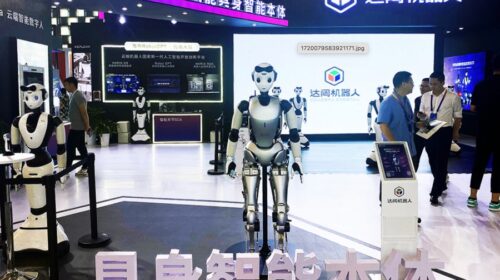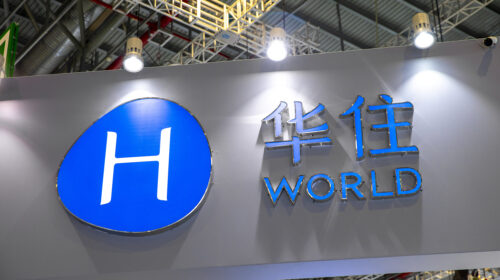Hisense Home Appliance switches on overseas growth engine

The home appliance maker’s ‘China first doesn’t mean the world is second’ campaign at the UEFA European Soccer Championship triggered discussion at home and abroad
Key Takeaways:
- Hisense Home Appliance’s profit rose 34.6% to 2.02 billion yuan in the first half of this year, propelled by the company’s rapid overseas growth
- Investment banks are bullish on the company, many rating it a “buy,” encouraged by the strong potential of its overseas business
By A. Au
Chinese brands have become regular fixtures these days at major international sporting events like the UEFA European Soccer Championship in June. But one campaign at that event from Hisense Home Appliances Group Co. Ltd. (0921.HK) was notable for the discussion it sparked both at home and abroad.
The rising appliance maker’s use of the tag line “China first doesn’t mean the world is second” seemed aimed at sending a message of co-existence between Chinese and global brands, even as trade frictions heat up between China and the West. That message is taking on special importance for the company as it looks abroad to boost its sales to offset a slowdown in its home market.
The appearance at the UEFA Championship wasn’t the first for Hisense at the event, even if it may have attracted the most attention. The sponsorship was the company’s third time backing the tournament, and its fifth time sponsoring a leading international soccer event since 2016. It is hoping to impress the world with its visuals and messages, paving the way for its ongoing global expansion.
Hisense reported revenue of 48.6 billion ($6.83 billion) yuan in the first half of this year, up around 13.3% year-on-year. Most of that growth came from its overseas home appliance sales, which rose 36.9% to 14.8 billion yuan – more than enough to offset sluggish sales at home. Its net profit for the six-month period jumped by an impressive 34.6% to 2.02 billion yuan, even as many Chinese companies were reporting falling profits.
Chinese home appliance companies have struggled in the last two years due to the nation’s property downturn that has seen new home construction slow sharply, compounded by intensifying competition. Authorities have rolled out a slate of measures to support home appliance makers, such as offering subsidies for consumers who trade in their old products for new ones. The city of Shenzhen also introduced subsidies worth 15% of the price for upgrades to energy-efficient home appliances earlier this month, and an additional 5% for the most energy efficient products. Shanghai also recently unveiled a similar program.
Hisense is being quite up front about how the property weakness is weighing on demand for its home appliances. Despite that, it still managed to eke out 3.5% growth in domestic sales in the first half of the year, with the figure reaching 25.3 billion yuan. But the big surprise for investors was the company’s strong performance in the Americas and Europe, where it is aggressively promoting its wares.
The Americas performed the best, with 40% revenue growth, mostly thanks to products sold from its factory in Monterey, Mexico, which has helped to expand its local sales and distribution channels. Its Americas refrigerator sales surged 97.3%, and revenue from its freezers and washing machines in the market rose by 92% and 97%, respectively.
Its European revenue also grew 14%, with refrigerator sales up 16.9% and freezer sales soaring three times, helping it to capture an additional 1.4 percentage points in market share. Its air conditioner sales in the region jumped by 26.8%, following the launch of a local air conditioner research center to capitalize on local market trends.
Surging in Southeast Asia
The company also performed well in Southeast Asia, with revenue up 39.5% in the first half, including a 64.4% surge for its self-developed brands. Meanwhile, its revenue from the Middle East and Africa region also rose 27%, driven by its sponsorship of sporting events, with revenue growth ranging from 21% to 89% for various product categories such as refrigerators, freezers, air conditioners and washing machines. Its Asia Pacific revenue grew by 18.9% in the first half, mostly spurred by new product launches in Australia.
The company’s strong overseas showing owes partly to its aggressive use of sporting event sponsorships since 2016. That year it sponsored the UEFA European Soccer Championship for the first time, kicking off a journey to boost its brand recognition. It has now been rated among the top 10 globalized Chinese brands for seven successive years.
The company started to tout a tag line saying “The world is second, China is first” in 2022 as its TV sales were on the rise. The company accounted for 26.9% of total TV sales volume and 29.1% of TV sales value in China last year, making it the industry leader, according to the data tracking All View Cloud platform. Data from market consultant Omdia shows the company’s overseas TV sales last year grew 13.9%. And according to the market research firm AVC Revo, Hisense’s total TV sales accounted for 14.3% of the global total in the first four months of this year, making it the second-largest seller globally.
Many investment banks are also bullish that the overseas market is becoming an important growth driver for the company, and have given the stock a “buy” rating. Kaiyuan Securities pointed out that the rapid growth of Hisense’s overseas business has helped to improve the company’s gross margin and profitability.
Guolian Securities said the company’s air conditioner business was poised to expand further overseas and that its traditional home appliance business portfolio would see structural improvement at Hisense puts more emphasis on its self-developed brands. Chasing Securities stressed that the company’s exports have outperformed its domestic sales and led to steady profit growth.
The company said in its latest financial report that boosting its overseas growth would be a top priority in the second half of this year. It added it will move ahead with integrating its various overseas research centers, production bases and local business centers to improve its offshore abilities and further extend its overseas business growth.
However, its overseas journey will not be without hurdles. Ongoing tensions between China and the West have led to a steady stream of new tariffs on Chinese goods in the U.S. and Europe, and there’s no guarantee home appliance won’t get hit with such measures in the future. Back at home, meanwhile, Hisense may have to wait for consumer confidence to improve before it can benefit from the recent wave of trade-in programs and other policy stimulus.
To subscribe to Bamboo Works free weekly newsletter, click here






